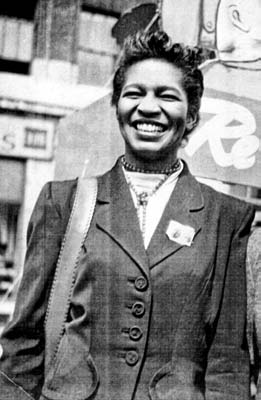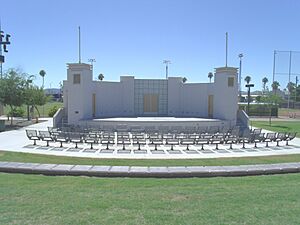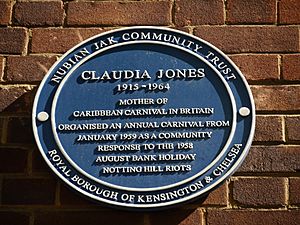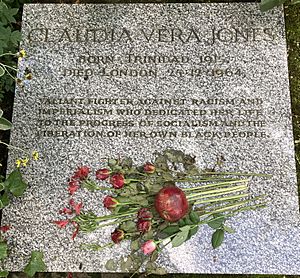Claudia Jones facts for kids
Quick facts for kids
Claudia Jones
|
|
|---|---|
 |
|
| Born |
Claudia Vera Cumberbatch
21 February 1915 Belmont, Port of Spain, Trinidad and Tobago
|
| Died | 24 December 1964 (aged 49) London, England
|
| Resting place | Highgate Cemetery |
| Nationality | Trinidadian |
| Other names | Claudia Cumberbatch Jones |
| Occupation | Journalist, activist |
| Years active | 1936–1964 |
| Known for | Organiser of 1959 Caribbean Carnival event, precursor of the Notting Hill Carnival. Founder of Britain's first major black community newspaper. Communist activism. |
| Political party | Communist Party USA, Communist Party of Great Britain (CPGB) |
| Criminal charge(s) | Charged under the McCarran Act |
| Criminal penalty | Imprisonment and eventual deportation to the United Kingdom |
| Relatives | Trevor Carter (cousin) |
Claudia Vera Jones (born Cumberbatch; 21 February 1915 – 24 December 1964) was a journalist and activist born in Trinidad and Tobago. When she was a child, her family moved to the United States. There, she became an activist who fought for equal rights for all people, especially for women and Black communities. She also supported the ideas of communism, which is a political and economic system. She changed her last name to Jones to protect herself.
Because of the strong anti-communist feelings in the US at the time, she was forced to leave the country in 1955. She then moved to the United Kingdom. In the UK, she immediately joined the Communist Party of Great Britain. She stayed a member for the rest of her life. In 1958, she started Britain's first major newspaper for the Black community, called the West Indian Gazette. She also played a very important part in starting the Notting Hill Carnival, which is now the second-largest yearly carnival in the world.
Contents
Early Life and Moving to the US
Claudia Vera Cumberbatch was born in Trinidad on 21 February 1915. Trinidad was a colony of the British Empire back then. When she was eight years old, her family moved to New York City. They moved after a big drop in cocoa prices in Trinidad made life very hard.
Five years later, her mother passed away. Her father eventually found work to support the family. Claudia was a bright student. She won the Theodore Roosevelt Award for Good Citizenship in junior high school. In 1932, at age 17, she got tuberculosis because of the poor living conditions in Harlem. This illness badly damaged her lungs. It caused her to spend a lot of time in hospitals throughout her life. She finished high school, but her family could not afford for her to go to her graduation ceremony.
In 1936, Jones joined the Young Communist League (YCL). She joined after hearing how the Communist Party defended the Scottsboro Boys. She later worked on the YCL's newspaper. She became the state education director and chairperson for the YCL.
Working for Change in the United States

Even though Claudia was very smart, being an immigrant woman limited her job choices. Instead of going to college, she started working in a laundry. She then found other retail jobs in Harlem. During this time, she joined a drama group. She also began writing a column called "Claudia Comments" for a Harlem newspaper.
In 1936, she joined the Young Communist League USA. She was looking for groups that supported the Scottsboro Boys. The American communist movement's opposition to Italy's invasion of Ethiopia also encouraged her to join. In 1937, she joined the team that edited the Daily Worker newspaper. By 1938, she became the editor of the Weekly Review.
After the Young Communist League changed its name to American Youth for Democracy during World War II, Jones became the editor of its monthly magazine, Spotlight. After the war, Jones became an important leader in the Communist Party USA (CPUSA). She worked to support women's rights and peace. In 1953, she became the editor of Negro Affairs.
A Leader for Black Women's Rights
As a member of the Communist Party USA, Claudia Jones focused on bringing people together. She wanted to create a strong group led by working-class people. She especially wanted women to be involved.
Jones worked hard to get more support for Black and white women within the party. She fought for Black women to be respected as mothers, workers, and women. She pushed for job training programs and equal pay. She also wanted the government to control food prices and fund childcare during the war. Jones believed in training women in political ideas. She also wanted to organize women into large groups. She even suggested funds for babysitters so women could be more active.
"An End to the Neglect of the Problems of the Negro Woman!"
One of Jones' most famous writings was "An End to the Neglect of the Problems of the Negro Woman!". It was published in 1949 in the magazine Political Affairs. In this article, she showed how different types of unfairness, like racism and sexism, are connected. She wrote about how Black women face unique challenges.
She explained that powerful people were afraid of how strong Black women were. She believed that when Black women took action, it made the whole Black community stronger. She wrote that Black women have always protected their families. They fight against unfair laws and living conditions that harm their health and lives. Jones pointed out that it was no accident that Black women faced extra hardship. This showed how unfair society was becoming.
Forced to Leave the US
Claudia Jones was an elected member of the National Committee of the Communist Party USA. She also organized and spoke at many events. Because of her involvement with the CPUSA, she was arrested in 1948. This was the first of four times she would be sent to prison. While held on Ellis Island, she was told she might be sent back to Trinidad.
She was found to have broken the McCarran Internal Security Act. This law said that non-US citizens who joined the Communist Party could be deported. Jones had identified herself as a party member since 1936. She was ordered to be deported on 21 December 1950.
In 1951, at age 36, she had her first heart attack while in prison. That same year, she was found guilty with 11 others. They were accused of "un-American activities" under the Smith Act. This meant they were accused of acting against the US government. The charges against Jones were about an article she wrote called "Women in the Struggle for Peace and Security". The Supreme Court would not hear their appeal.
In 1955, Jones began her prison sentence at the Federal Reformatory for Women in Alderson. She was released on 23 October 1955.
She was not allowed to return to Trinidad and Tobago. The governor there thought she "may prove troublesome". She was eventually offered a place to live in the United Kingdom. This was allowed because of her health, and she agreed to stop fighting her deportation. On 7 December 1955, 350 people gathered at Harlem's Hotel Theresa to say goodbye to her.
Activism in the United Kingdom
Jones arrived in London two weeks later. At this time, the British African-Caribbean community was growing. When she arrived, members of the Communist Party of Great Britain greeted her. These included Billy Strachan, Winston Pinder, and her cousin Trevor Carter. However, she was disappointed to find that some British communists were not welcoming to a Black woman. She immediately joined the CPGB and remained a member until her death.
Fighting for Rights
Jones found a community in the UK that needed help and organization. She became involved in the British African-Caribbean community. She worked to help them get basic services and to start the movement for equal rights.
With help from her cousin Trevor Carter and friends like Nadia Cattouse and Paul Robeson, Jones campaigned against racism. She fought for fair housing, education, and jobs. She spoke at peace rallies and trade union meetings. She also visited Japan, Russia, and China, where she met with Mao Zedong.
In the early 1960s, her health was getting worse. Despite this, Jones helped organize campaigns against the Commonwealth Immigrants Act 1962. This law made it harder for non-white people to move to Britain. She also campaigned for the release of Nelson Mandela. She spoke out against racism in workplaces.
=West Indian Gazette and Afro-Asian Caribbean News
From her experiences in the United States, Jones believed that "people without a voice were like lambs to the slaughter." This meant she felt people needed a way to speak up. In March 1958, she started a newspaper called the West Indian Gazette. Its full name later became West Indian Gazette and Afro-Asian Caribbean News (WIG). She edited the paper from a shop in Brixton.
The newspaper became very important in raising awareness within the Black British community. Jones wrote in her last essay that the newspaper helped people become more aware socially and politically. It supported a united and independent West Indies. It also fought for full equality and respect for West Indians and Afro-Asians in Britain.
WIG always struggled for money. It closed eight months after Jones's death in December 1964.
Notting Hill Riots and "Caribbean Carnival"
In August 1958, four months after WIG started, there were race riots in Notting Hill and Nottingham. Other newspapers did not report on these events fairly. Because of this, Jones started getting visits from members of the Black British community. Leaders from other countries also came to her. They included Cheddi Jagan from British Guiana and Norman Manley from Jamaica.
Claudia felt that these events needed to be "washed out of our mouths." Someone suggested that the British Black community should have a carnival. It was December 1958, so the question was: "In the winter?" Jones used her connections to get St Pancras Town Hall for January 1959. This was for the first Mardi-Gras-based carnival. It featured performances by Edric Connor, the Boscoe Holder Dance Troupe, and singer Cleo Laine. The event was shown on national TV by the BBC. The slogan for these early celebrations was: "A people's art is the genesis of their freedom."
A note in the 1959 souvenir program said that some money from the brochure sales would help pay fines for young people involved in the Notting Hill events. Jones and the West Indian Gazette also organized five other yearly indoor Caribbean Carnival shows. These events were held in London at places like Seymour Hall and the Lyceum Ballroom. These shows are seen as the beginnings of the famous Notting Hill Carnival.
Death and Legacy
Claudia Jones passed away in London on Christmas Eve 1964. She was 49 years old. She was found on Christmas Day at her apartment. Doctors said she had a massive heart attack due to heart disease and tuberculosis.
Her funeral on 9 January 1965 was a large and important event. She was buried next to the tomb of her hero, Karl Marx, in Highgate Cemetery, North London. A message from Paul Robeson was read. He said it was a great honor to have known Claudia Jones. He called her a strong and brave leader who worked for unity, dignity, and equality for all people, especially for Black people and women.
Legacy and Influence
The Black Members' Council of the National Union of Journalists holds an important yearly lecture in October. This lecture, called the Claudia Jones Memorial Lecture, honors her and her work in Black-British journalism. It takes place during Black History Month.
The Claudia Jones Organisation was started in London in 1982. It was founded by Yvette Thomas and others. Its goal is to support and empower women and families of African-Caribbean heritage.
Winsome Pinnock's 1989 play A Rock in Water was inspired by Claudia Jones's life. Jones is also named in the list of 100 Great Black Britons (2003 and 2020).
In August 2008, a blue plaque was put up in Notting Hill. It honors Claudia Jones as the "Mother of Caribbean Carnival in Britain." In October 2008, Britain's Royal Mail honored Jones with a special postage stamp.
She is the subject of a documentary film by Z. Nia Reynolds, called Looking for Claudia Jones (2010). In 2018, the Evening Standard newspaper listed Jones as one of 14 "Inspirational black British women throughout history."
Bustle magazine also included Jones on a list of "7 Black British Women Throughout History That Deserve To Be Household Names In 2019." Jones appeared as an important character in Yasmin Joseph's 2019 play J'Ouvert. On 14 October 2020, Jones was honored with a Google Doodle.
A sculpture of Claudia Jones by artist Favour Jonathan is on display at Black Cultural Archives in Brixton. It was created as part of the 2021 Sky Arts series Landmark.
Images for kids






